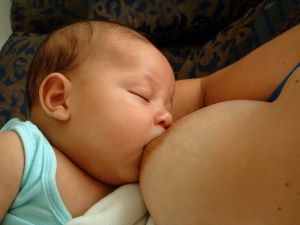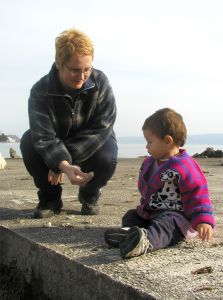 By Naomi Aldort, author of Raising Our Children, Raising Ourselves, www.naomialdort.com
By Naomi Aldort, author of Raising Our Children, Raising Ourselves, www.naomialdort.com
Q: My husband will be going away for eight weeks in the near future. I am wondering how I can ease the stress of this separation on my 20-month-old son. My son is quite verbal, very sensitive, and very spirited. He is aware that Daddy is going to work, and has shown signs of stress already (potty training regression). What can I do to help my baby?
A: A baby who is loved and cared for by his mother and expresses his feelings fully can handle a lot more than we realize. Instead of wanting your baby not to experience anxiety, be present for his emotional expression. Children constantly heal themselves if we don’t get in their way or try to stop them.
Let your toddler go back to wearing diapers fully if he needs to, and support any crying, whining, and self-expression. He must go through the experience of missing dad, not avoid it. If you try to cheer him up and “avoid” the feelings, he learns that feelings are scary and that it is horrible to feel them. What heals him moment by moment is fully expressing himself.
To validate without drama, be sure that you don’t make up ideas that he is not feeling. If he cries and asks for his daddy, validate and reassure. He may be afraid that you would go, too. You can say things like, “You want Daddy to be here. Mommy knows,” and, “Mommy will never go. Daddy goes and come back.”
Drama is when you say things like, “Oh, you miss your daddy so much, poor thing, what a bummer…” Drama scares children. You want to give your toddler a sense of peace so he learns, “I have the power to be without daddy.” He does have that power because he is loved and has you always with him.
Be careful not to plant your anxiety in your baby’s mind. At this age, the child is present moment by moment and feels happy in the moment. It is possible that what you see is a response to your anxiety more than to dad’s trip. So, keep your attitude positive and powerful. He can handle daddy being away if you can handle what he feels about it.
As for technical ideas to ease separation, try video chatting and phone calls even before the trip, to get him used to seeing daddy on the screen and hearing his voice. However, some babies are better off not being reminded about the person they don’t get to see, so try and see how he reacts.
How much your baby anguishes over his dad’s absence is a reflection of your attitude. It is the same as when the toddler falls without injury. He will look at you to check what he is supposed to feel. If you rush toward him alarmed, he will cry. If you smile and do nothing, he gets up and keeps going. Be at peace and open to his emotions, and your baby will learn from you that he can go through this experience powerfully and joyfully.

 There are some things that simply drive us parents crazy: One is when your child insists on doing something that you want to do yourself. You are trying to feed your 1-year-old mashed potatoes and carrots, and he clamps his mouth shut while squashing the mixture through his fingers. You finally finish dressing your 3-year-old so you can make it on time to work, only to find that she has undressed herself 2 minutes later because she wants to do it herself. And as you are carefully unpacking the groceries, your 6-year-old silently volunteers to put the tray of 36 eggs into the refrigerator. (These examples are just for starters. I’m sure you’ll think of many more)!
There are some things that simply drive us parents crazy: One is when your child insists on doing something that you want to do yourself. You are trying to feed your 1-year-old mashed potatoes and carrots, and he clamps his mouth shut while squashing the mixture through his fingers. You finally finish dressing your 3-year-old so you can make it on time to work, only to find that she has undressed herself 2 minutes later because she wants to do it herself. And as you are carefully unpacking the groceries, your 6-year-old silently volunteers to put the tray of 36 eggs into the refrigerator. (These examples are just for starters. I’m sure you’ll think of many more)!
 I don’t encourage the use of lovies – blankets, teddy bears, or other objects children can develop an attachment to – in my household but I don’t discourage it, either.
I don’t encourage the use of lovies – blankets, teddy bears, or other objects children can develop an attachment to – in my household but I don’t discourage it, either. Breastfeeding may be particularly important to the educational and emotional development of children from single-parent and low-income families, new research suggests.
Breastfeeding may be particularly important to the educational and emotional development of children from single-parent and low-income families, new research suggests. From API’s Publications Team
From API’s Publications Team A study to be published in the March issue of Behavior Therapy, “Generalized Anxiety Disorder: Connections with Self-Reported Attachment,” credits secure parent-child attachment in lessening the risk of that child eventually developing a severe anxiety disorder as an adult.
A study to be published in the March issue of Behavior Therapy, “Generalized Anxiety Disorder: Connections with Self-Reported Attachment,” credits secure parent-child attachment in lessening the risk of that child eventually developing a severe anxiety disorder as an adult.